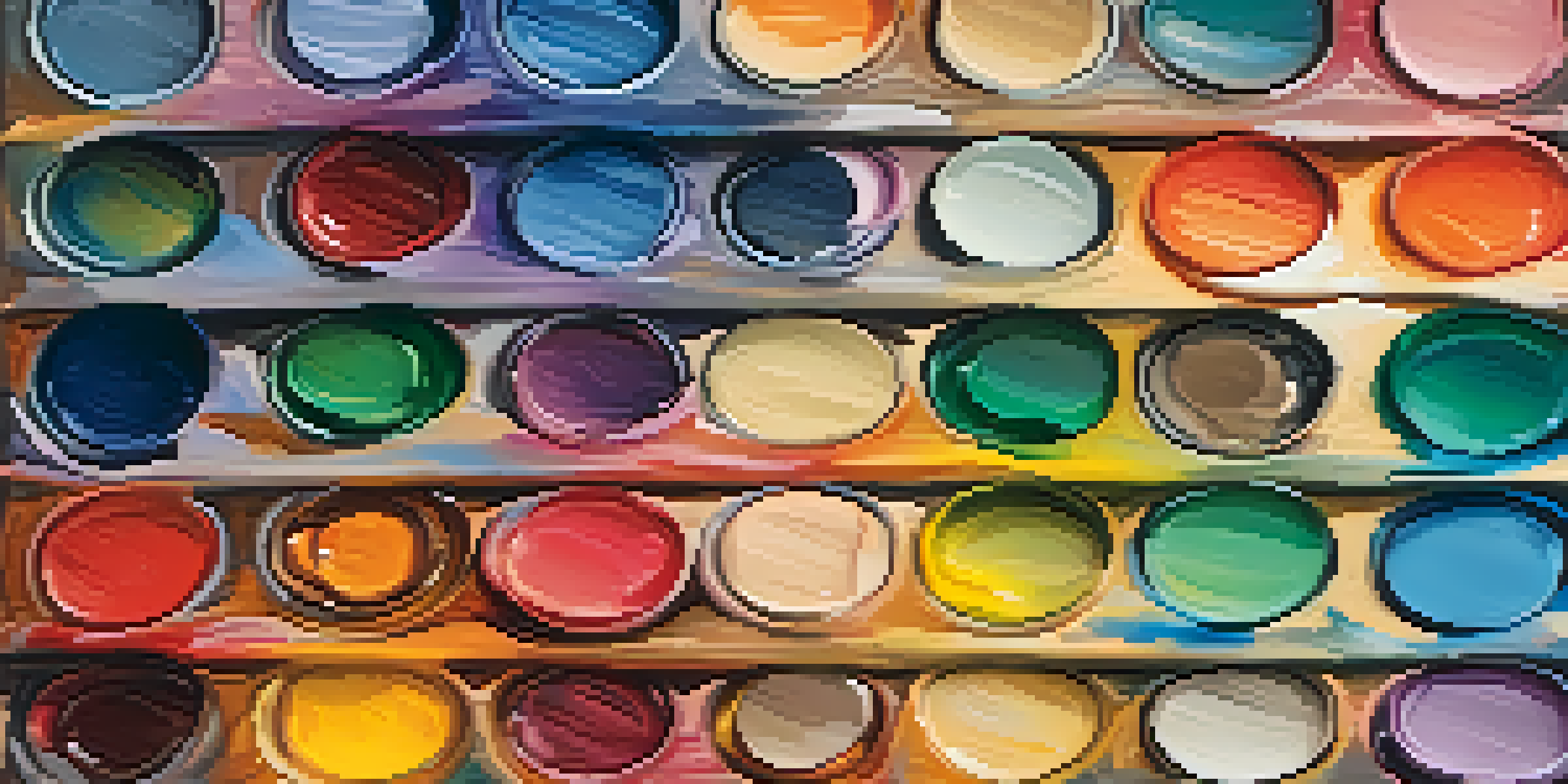The Chemistry of Pigments: What Makes Paint Colorful?

What Are Pigments and Why Do They Matter?
Pigments are the substances that give paint its color. They work by absorbing certain wavelengths of light while reflecting others, which is why we perceive different colors. For example, a red pigment absorbs green and blue light, reflecting red light back to our eyes.
Color is the keyboard, the eyes are the harmonies, the soul is the piano with many strings.
In the world of art and design, the choice of pigment can dramatically affect the mood and feel of a piece. Artists often select pigments based not just on color but also on their opacity, tinting strength, and permanence. This selection process is crucial for achieving the desired effect in a painting.
Understanding pigments is essential for anyone involved in painting, whether it's a professional artist or a DIY enthusiast. The right pigment can enhance the beauty of a piece, while the wrong one can lead to unexpected results, making knowledge of pigments foundational in creating colorful artworks.
The Science of Color: How Light Interacts with Pigments
Color perception begins with light. When light hits a pigment, certain wavelengths are absorbed while others are reflected. This interaction determines the color we see; a blue pigment reflects blue wavelengths and absorbs others.

This phenomenon is not just limited to visible light; pigments can also interact with ultraviolet (UV) and infrared light. Some pigments can reflect UV light, which is why certain paints can feel cooler than others under the sun. This interaction highlights the complexity of how pigments behave in different lighting conditions.
Understanding Pigments is Crucial
Knowledge of pigments is foundational for artists and DIY enthusiasts, as the right choice can enhance artwork while the wrong one can lead to unexpected results.
By understanding how light interacts with pigments, we can appreciate the intricacies of color mixing and layering in painting. For instance, mixing two pigments may produce a new color entirely, thanks to how their respective wavelengths combine or cancel each other out.
Natural vs. Synthetic Pigments: A Colorful Contrast
Pigments can be broadly categorized into natural and synthetic types. Natural pigments are derived from organic sources like plants and minerals, while synthetic pigments are created through chemical processes. This distinction can influence everything from color vibrancy to durability.
The best color in the whole world is the one that looks good on you.
Natural pigments often have a warm, earthy quality, which many artists find appealing. However, they can be less lightfast, meaning they may fade over time when exposed to sunlight. In contrast, synthetic pigments can offer a wider range of vibrant colors and better longevity.
The choice between natural and synthetic pigments often comes down to personal preference and specific project needs. Some artists prefer the traditional feel of natural pigments, while others embrace the endless possibilities offered by modern synthetic options.
The Role of Binders in Paint and Pigment Interaction
Binders are essential components in paint that hold pigments together and help them adhere to surfaces. Common binders include oils, acrylics, and water. The type of binder used can significantly affect the final appearance and texture of the paint.
For instance, oil-based paints tend to have a glossy finish and longer drying times, allowing for more blending and layering. On the other hand, acrylics dry quickly and can produce a matte finish, which some artists prefer for their immediacy and versatility.
Natural vs. Synthetic Choices Matter
The distinction between natural and synthetic pigments influences aspects like color vibrancy and durability, impacting an artist's material selection.
Understanding the role of binders helps artists make informed choices about their materials. The right binder can enhance the vibrancy of pigments, while the wrong choice can lead to a dull appearance, showcasing the importance of this aspect in paint formulation.
Color Theory: How Pigments Work Together
Color theory is a framework that artists use to understand how colors interact with one another. It includes concepts such as complementary colors, analogous colors, and triadic color schemes. These principles can guide artists in creating harmonious compositions.
For example, complementary colors—like blue and orange—create a striking contrast that can make a painting pop. By utilizing pigments strategically according to color theory, artists can evoke emotions and draw attention to specific areas of their work.
In practice, applying color theory requires a blend of knowledge and intuition. Artists often experiment with different pigment combinations to see how they can create depth, mood, and focus within their pieces, making color theory a vital part of the artistic process.
The Impact of Environmental Factors on Pigment Performance
Environmental factors play a significant role in how pigments perform over time. Factors such as humidity, temperature, and exposure to light can affect the stability and appearance of paint. Artists must consider these variables when selecting materials for their projects.
For instance, high humidity can slow down the drying process of oil paints, potentially leading to issues like mold growth. On the other hand, extreme heat can cause colors to fade more quickly, especially in lighter shades. Understanding these effects can help artists protect their work.
Environmental Factors Affect Performance
Humidity, temperature, and light exposure play significant roles in how pigments perform, making it essential for artists to consider these factors when creating.
Additionally, some pigments are more sensitive to environmental changes than others. Knowledge of these sensitivities allows artists to take precautions, such as using UV-protective varnishes or selecting more stable pigment options for outdoor works.
Conclusion: The Art and Science of Pigment Choice
The chemistry of pigments is a fascinating blend of art and science. By understanding how pigments work, artists can make informed decisions about their materials, leading to more successful and vibrant artworks. Whether choosing natural or synthetic pigments, the possibilities are endless.
Moreover, the relationship between pigments, binders, and environmental factors adds layers of complexity to the creative process. Artists who grasp these elements can better navigate the challenges of color mixing, layering, and durability.

In the end, the choice of pigments is not just a technical decision; it is an expression of creativity. By embracing the chemistry behind pigments, artists can unlock new dimensions in their work, making their creations even more colorful and impactful.